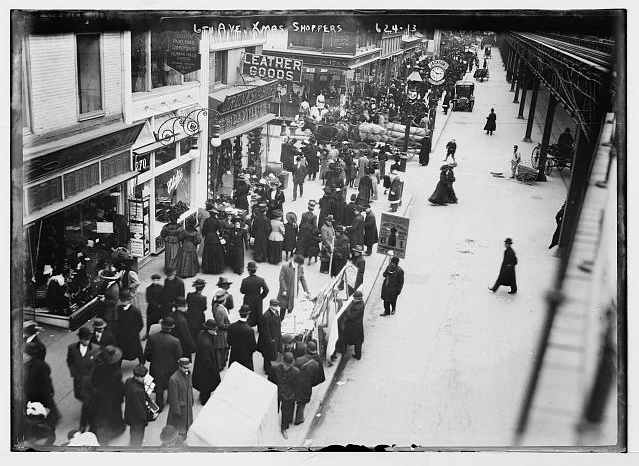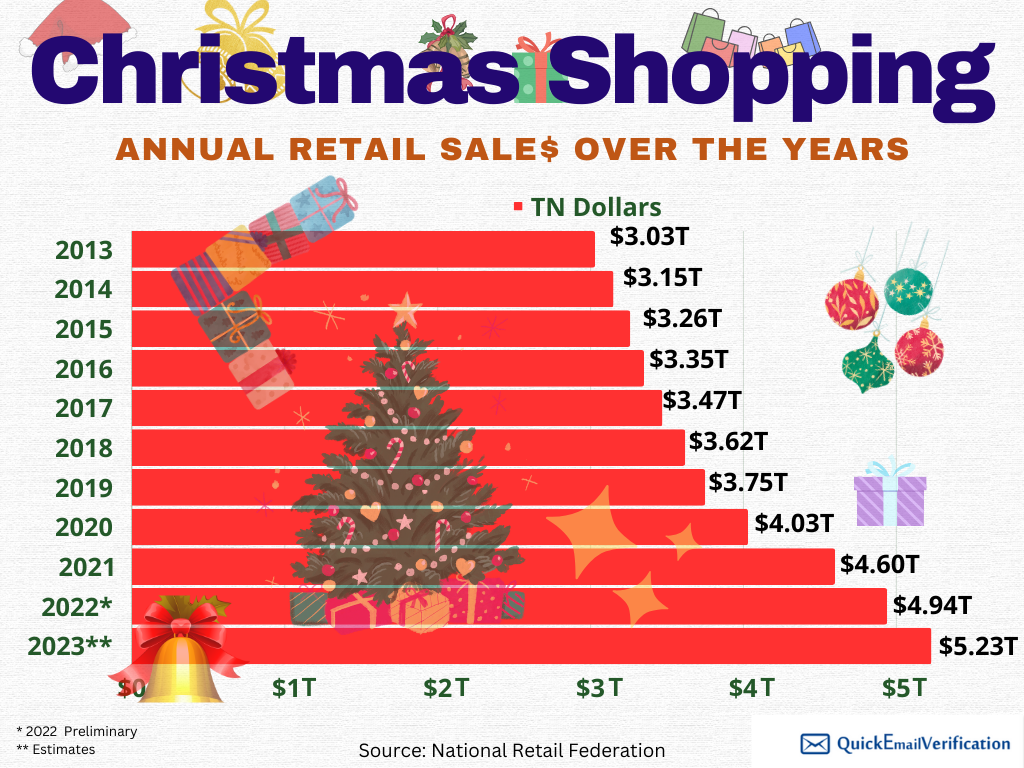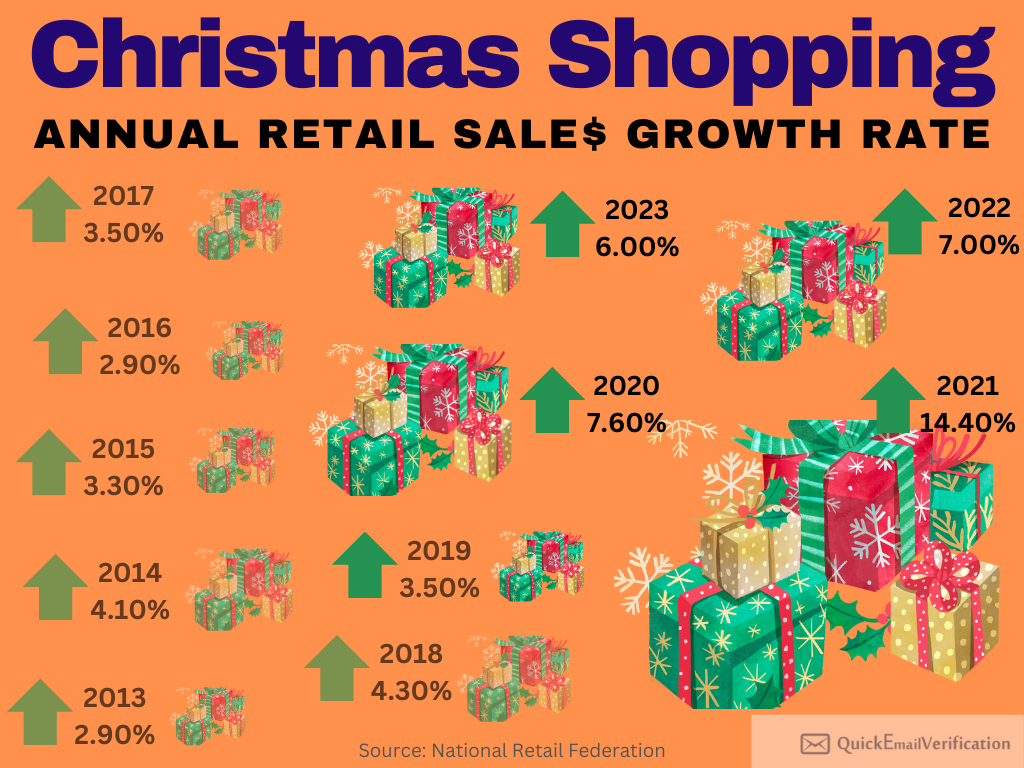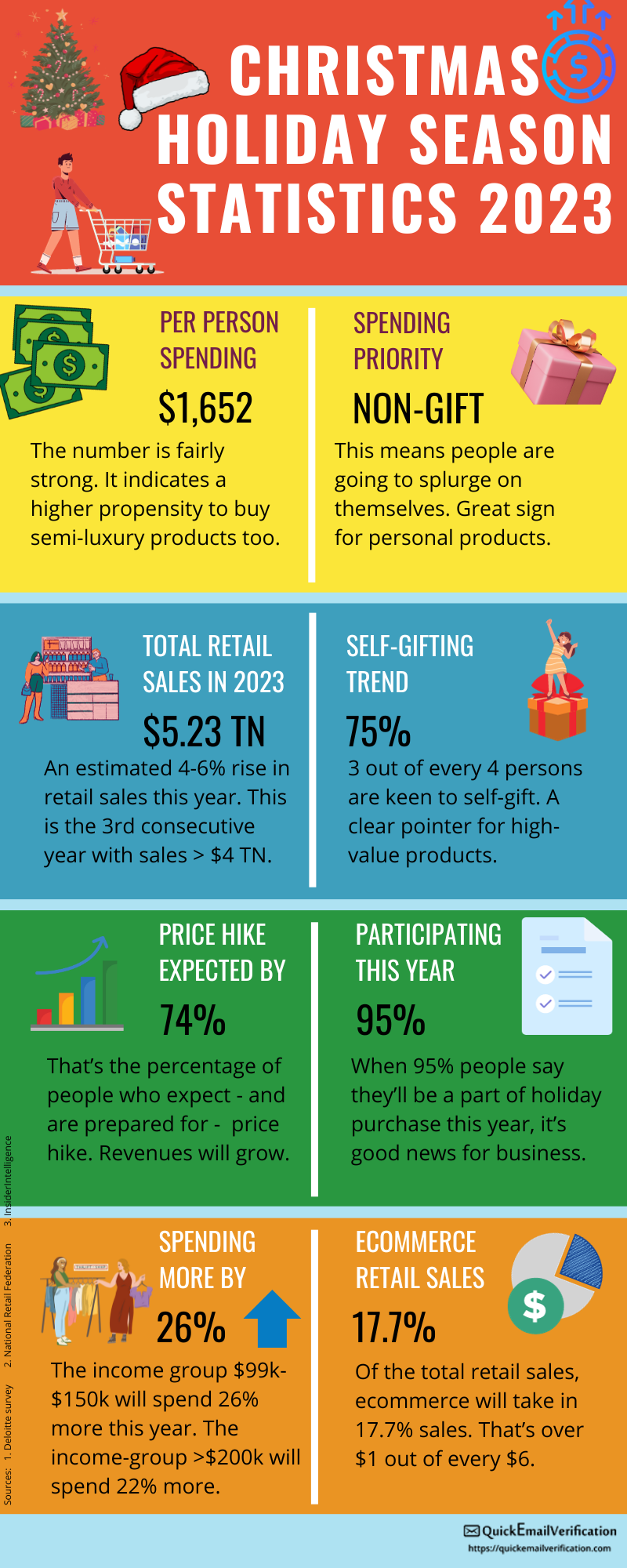Want a peek at the top holiday retail sales statistics? Guess what, you’re not alone! As Christmas nears, it’s only natural that marketers like you double check the shopping trends data. Because that way, you can make sure you have the right holiday marketing strategy in place.
The article below has collected data on US holiday season sales from multiple sources. That includes National Retail Federation (NRF), Deloitte, InsiderIntelligence, and others. Go ahead, check out the latest holiday spending statistics and estimates below. And crush your Christmas marketing goals!
But first, a quick dive into history!

The above is a photograph (Source) from 6th Avenue in NewYork during shopping season. Can you guess the year?
It’s 1910! That’s 113 years back! Enough proof how old and popular Christmas shopping has been!
Okay, so now we start with the two most important questions regarding holiday retail sales figures:
- How much money are consumers spending in the year-end shopping season?
- Where are they spending that money?
Average per capita spending in Christmas 2023
We’ll start with the bigger picture first.
As per the numbers emerging from holiday shopping trends 2023, consumers will be spending an average of US$ 1,652. This estimate, published by Deloitte, is significant because of two reasons:
- It’s the first time after Covid-19 that any Christmas stats on retail has surpassed the pre-pandemic levels. It shows a clear and healthy recovery, which is great news.
- The bounce back will add confidence to Christmas email marketing campaigns. Because email marketing has one of the highest ROI!
While you work on building your email list, make sure you keep this number in mind.

Where the holiday shopper is spending money
A key figure in the list of Christmas shopping facts is where the shoppers plan to spend.
Let’s put the answer this way: There’s a 25% rise (YoY) on non-gift purchases.

You would probably remember what tourism industry professionals had labeled revenge tourism – the inclination to spend more on travel after the pandemic ended. People who had been forced to stay indoors and honor lockdown and social distancing spent substantially more when they traveled.
Here is something promising for sellers of furnishing items, dresses, and Christmas decorations.

This piece of holiday retail sales statistics (also from Deloitte) has an interesting twist. It may interest e-commerce retail professionals that 75% of consumers reported they will be self-gifting. There, with a little tweak in your strategy, you can earn a higher spending per user.

What the holiday shopping trends indicate
Ok, so now we’ll look at Christmas spending trends over the years.
As always, the National Retail Federation has data on virtually everything you need to know about holiday retail sales.
Let’s begin with the total retail sales during Christmas, right from the year 2013.
The best part of the numbers is the total sales have never decreased in all these years. Sure, some years have shown relatively more modest growth in sales than other years. But the most important part is holiday retail sales have grown each year.
Preliminary figures for the year 2022 showed sales worth $4.6TN – and that’s the third consecutive year with sales in excess of $4TN.
For the year 2023, NRF analysts expect a holiday season sales growth ranging between 4% and 6% (the chart below uses 6% growth estimates).
Hence, the Christmas holiday sales for the year 2023 will be between $5.13TN to $5.23TN.
Below is the annual retail sales for Christmas every year, since 2013.

Equally promising is the story of holiday season sales growth in retail.
The growth figures vary significantly: sales grew by 2.90% in 2016, while the same for 2021 is a staggering 14.40%!
And perhaps the best part is, Christmas retail sales have never dropped.

The above shows the Christmas shopping growth rate in annual retail sales since 2013.
We’ll let you in on a secret!
These figures are extremely motivating for an email marketer, because email marketing is a big hit during shopping seasons. And what do you think is the secret behind successful email campaigns?
Be sure you craft your email opening lines carefully, because that’s often a deal-breaker for most customers.
Holiday retail sales figures: What stands out?
Depending upon the spending patterns of your target audience, average spending per buyer and other factors, the area of your interest in these figures will be different.
And yet, three key numbers in the Deloitte report on holiday retail sales stand out among the top Christmas marketing stats. These three are independent of industry, so you’ll want to pay attention.

1. 74% of customers expect a price rise
Ask any marketer and they’ll tell you how difficult it is to get the pricing right.
Now that the customers are already expecting a price rise, convincing them as regards pricing is going to be a great deal easier.

2. More customers than before are participating
Look at the table below: over the past three years, the percentage of customers participating in holiday sales is constantly rising.

More participation obviously points toward a stronger growth. And a strong economy is good news for holiday retail sales figures.
3. Various income groups are increasing their holiday spending
Some income groups are increasing their spending by as much as a quarter of their previous numbers.
A quick glance at the figures below is enough to tell you that the year-end shopping season is going to be strong in 2023.

Ecommerce retail sales share
Another number to examine is ecommerce sales as a percentage of total retail sales.
The answer is: it’s 17.7% (Source).
Put differently, out of every $1,000 a buyer spends on retail purchase, $177 is spent through ecommerce sales.
That’s about one-fifth of the total spend, which is certainly impressive.

What major holiday retail sales estimates mean for you: A summing up
Ok, so now it’s time for a recap.
Let’s summarize the numbers and also mention the significance of the US holiday retail sales figures.

And here are the three most important takeaways:
- Splurge: People are going to spend more on themselves than ever before. Self-gifting is going to be big, and that means more opportunity to sell semi-luxury or even premium products. After all, everyone loves themselves the most, right?
- Ecommerce on the rise: With ecommerce taking in about 17.7% of the total holiday retail sales, there’s no looking back for online retailers. But that also means stiff competition.
- Price-hike acceptance: We’re not saying rising prices are good in themselves. But when businesses need to hike prices in order to accomodate rising costs and customers accept, it’s good for both. This year, 74% of people expect a price hike, which is a reasonably good piece of news.
Now that you have some really good stats around Christmas marketing for eCommerce and retail business, how are you adjusting your holiday marketing strategy?

